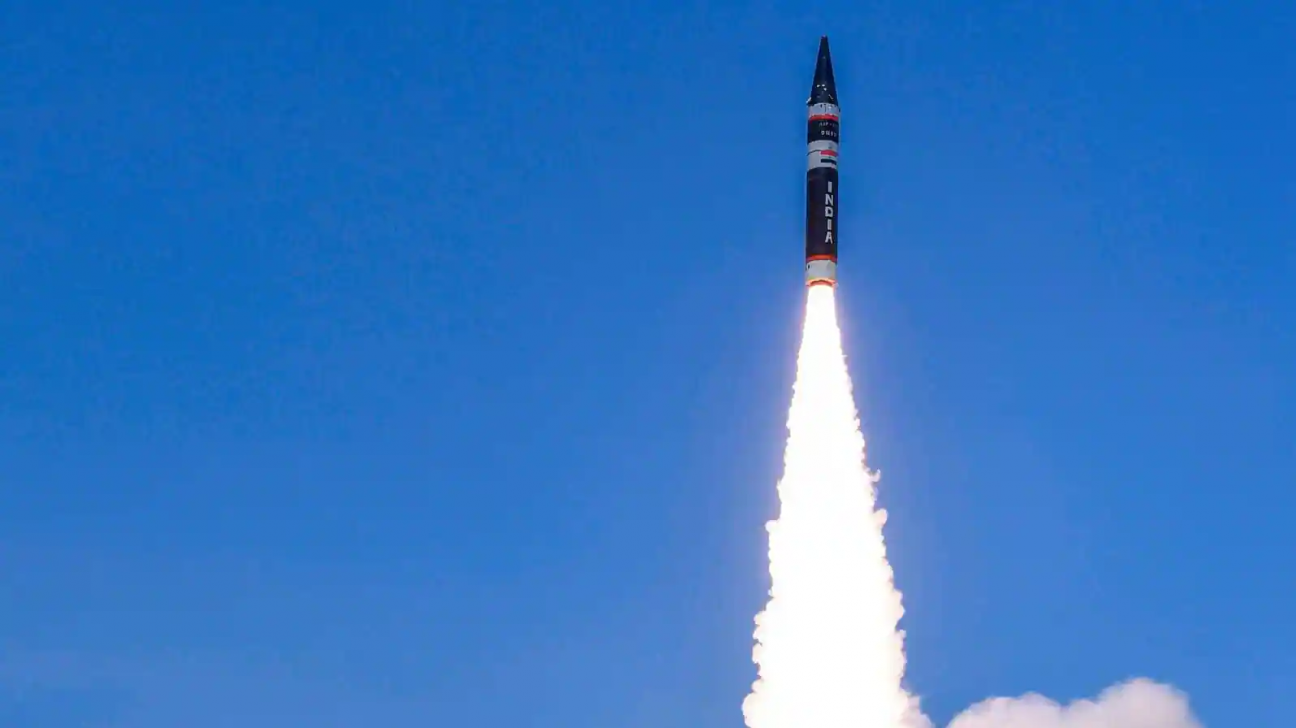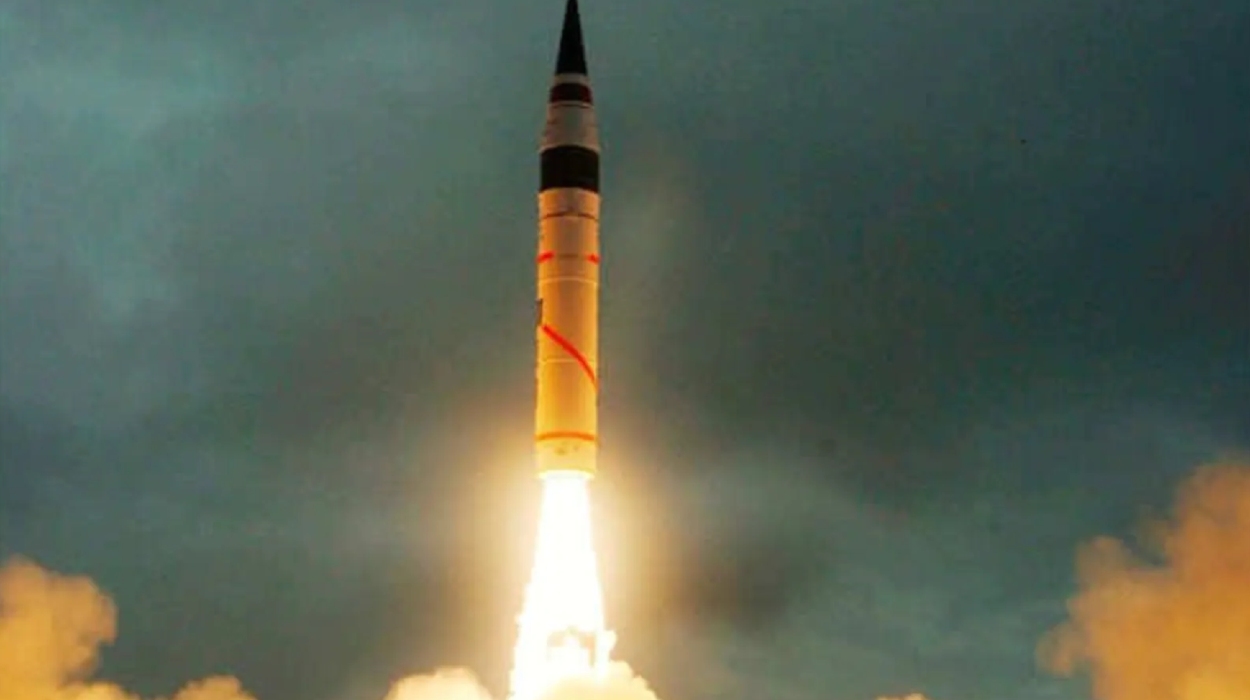India is overhauling its Strategic Forces Command (SFC), also known as Strategic Nuclear Command, one missile at a time. In the latest test, it tested its new-generation Agni-Prime ballistic missile, which has a 2,000-kilometer range and will counter threats from Pakistan.
China adheres to a No First Use (NFU) policy but has clearly mentioned that any country occupying or in possession of its territory, the NFU is null and void. Meanwhile, Pakistan does not adhere to a strict no-first-use policy. Instead, it maintains a first-use doctrine, which means that Pakistan will not wait for an adversary to use nuclear weapons first.
Indigenously developed Agni-V with Multiple Independently Targetable Re-entry Vehicle (MIRV) technology and the capability to strike targets at a 5,000-kilometer range has been developed with China in mind.
The Indian Defence Ministry announced the successful test firing of the country’s New Generation Ballistic Missile Agni-Prime from the Dr APJ Abdul Kalam Island off the Odisha coast. The latest test is the second pre-induction night launch of the Agni-Prime. The missile will replace the previous generation Agni-II with a range of 700 kilometers.
As Indian scientists increased the range of their missiles, the technology also evolved in terms of sophistication. In what could be called backward integration of technology, efforts are now being made to replace the missiles’ older technologies with more advanced technologies.
The Agni-P is the first shorter-range missile equipped with technologies found in newer Agni-IV and Agni-V ballistic systems like advanced rocket motors, propellants, avionics, and navigation systems.

Before Agni-P, India tested another technology in Agni-V, a feature absent in the previous variants of Agni—it is a canister-launch missile that ensures less maintenance and swifter deployment and firing. Agni-P also comes with cauterization.
Canisterisation means “storing the missiles inside a sealed, climate-controlled tube” to protect them from environmental elements during transportation. It allows permanent warhead mating with the missile and does not require installation before launch. This helps reduce the time needed to launch nuclear weapons should a crisis break out.
India tested the canister technology for the first time on the Agni-V in 2015, giving the SFC required flexibility to swiftly transport and fire the ballistic missiles from anywhere they want.
The canister makes the missile highly road-mobile. The 50-tonne missile can be fired from stop to launch in just a few minutes without compromising on reliability. The hermetically sealed canister also increases its shelf life and requires less maintenance.
The first two launches of the Agni-V were done using a rail launcher. Since 2015, all launches have been conducted from a road-mobile launcher.
“It has a very short reaction time. With India having a policy of no first use of nuclear weapons, it is highly survivable… gives full teeth to our policy of deterrence (in terms of an assured retaliatory-strike capability),” former chief of the Defense Research and Development Organisation (DRDO) Avinash Chander said at the time. Agni-V was touted as the most formidable missile in India’s arsenal, bringing the whole of China into its strike envelope.
Canister launch technology will now be operationalized across its suite of land-based nuclear delivery systems, encompassing both shorter—and longer-range missiles.
The Agni-P is also fuelled by solid fuels instead of liquid fuels. Liquid fuels are not easy to handle and store. Solid fuels can be pre-filled.
One Missile Multiple Target
In March, India successfully test-fired a long-range ballistic missile, Agni-V, with Multiple Independently Targetable Re-entry Vehicle (MIRV) technology. As reported by the EurAsian Times earlier, the technology gave India a more flexible deterrence vis-à-vis its two aggressive nuclear-powered neighbors– China and Pakistan.
India has maintained that the Agni-V missile is in line with India’s policy of “credible minimum deterrence,” which means that the country will develop only the nuclear weapons capabilities needed to deter adversaries.
India has been capable of striking the entire territory of its neighboring adversary in the West, Pakistan. New Delhi’s pursuit of longer-range systems, such as the Agni-V and submarine-launched ballistic missiles, is oriented at China, which is expanding its nuclear arsenal and has developed a larger missile force.
The range, coupled with canisterization and MIRV technology, makes Agni-V pack more punch. MIRVs allow a missile to carry multiple nuclear warheads, each independently targeted to different locations. These warheads can be released at varying speeds and directions, significantly enhancing a missile’s effectiveness.
MIRVs can penetrate ballistic missile defenses by overwhelming the defense system of the adversaries trying to intercept the multiple warheads. A MIRVed missile would be armed with multiple warheads, allowing a single missile to hit several different targets at once or hit a single target with multiple warheads. Such an arrangement would also make MIRVs harder to intercept with anti-missile technology.
MIRV is a complex technology that requires a combination of large missiles, small warheads, accurate guidance, and a mechanism for releasing warheads sequentially during flight.
Named ‘Divyastra,’ the MIRV technology of Agni-V can be replicated for other missiles in India’s inventory. The use of MIRVed missiles on submarines increases their survivability manifold, as nuclear submarines are difficult to locate.
The 50-tonne Agni-V’s operational deployment enhanced India’s deterrence posture against China, which has missiles like the Dong Feng-41. With a range of 12,000-15,000 kilometers, the DF-41 can hit any Indian city. Agni-V brought the northernmost part of China within India’s striking range, and its canister launch paved the way for a swifter launch.

The Third Leg Of India’s Nuclear Triad
Submarine-launched ballistic missiles (SLBMs) have been the Achilles Heel for Indian nuclear deterrence. The US, China, and Russia have nuclear-powered submarines capable of deploying SLBMs well over the range of 5000 kilometers. To bridge the gap, India has been pursuing K-4 missiles with a strike range of 3,500 kilometers.
The missile was test-fired from the indigenous nuclear-powered submarine INS Arihant in 2022.
The Submarine-Launched Ballistic Missiles (SLBMs), sometimes called the ‘K’ family of missiles, were indigenously developed by the Defence Research and Development Organisation (DRDO).
The missiles must be lighter, stealthier, and more compact than their land variants to be launched from submarines. Another part of the K-series of missiles is the SLBM K-15, also called B-05 or Sagarika. It has a range of 750 km. INS Arihant can carry a dozen K-15 missiles on board.
After K-4 and K-15, SLBMs with code names K-5 and K-6 capable of hitting targets in the range of 5,000 and 6,000 are also under development.
The capability of being able to launch nuclear weapons submarine platforms has great strategic significance in the context of achieving a nuclear triad, especially in the light of the “No First Use” policy of India.
The sea-bird underwater nuclear-capable assets significantly increase the second-strike capability, thus validating nuclear deterrence. These submarines can not only survive an adversary’s first strike but can also launch a strike in retaliation, thus achieving ‘Credible Nuclear Deterrence.’
- Ritu Sharma has been a journalist for over a decade, writing on defense, foreign affairs, and nuclear technology.
- The author can be reached at ritu.sharma (at) mail.com
- Follow EurAsian Times on Google News




